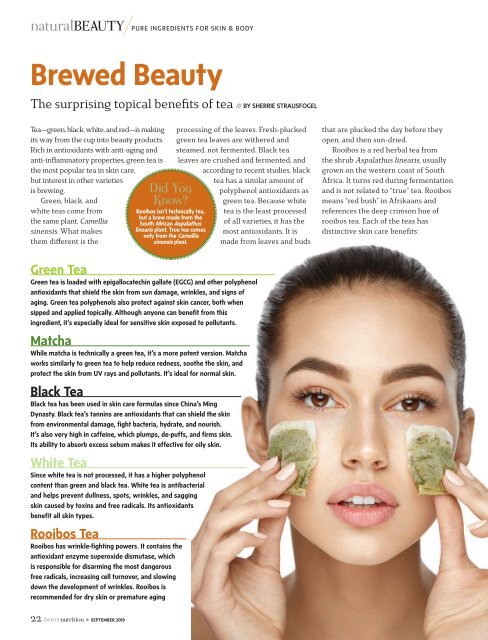Better Nutrition September 2019
Create successful ePaper yourself
Turn your PDF publications into a flip-book with our unique Google optimized e-Paper software.
naturalBEAUTY/PURE INGREDIENTS FOR SKIN & BODY<br />
Brewed Beauty<br />
The surprising topical benefits of tea /// BY SHERRIE STRAUSFOGEL<br />
Tea—green, black, white, and red—is making<br />
its way from the cup into beauty products.<br />
Rich in antioxidants with anti-aging and<br />
anti-inflammatory properties, green tea is<br />
the most popular tea in skin care,<br />
but interest in other varieties<br />
is brewing.<br />
Green, black, and<br />
white teas come from<br />
the same plant, Camellia<br />
sinensis. What makes<br />
them different is the<br />
Did You<br />
Know?<br />
Rooibos isn’t technically tea,<br />
but a brew made from the<br />
South African Aspalathus<br />
linearis plant. True tea comes<br />
only from the Camellia<br />
sinensis plant.<br />
processing of the leaves. Fresh-plucked<br />
green tea leaves are withered and<br />
steamed, not fermented. Black tea<br />
leaves are crushed and fermented, and<br />
according to recent studies, black<br />
tea has a similar amount of<br />
polyphenol antioxidants as<br />
green tea. Because white<br />
tea is the least processed<br />
of all varieties, it has the<br />
most antioxidants. It is<br />
made from leaves and buds<br />
that are plucked the day before they<br />
open, and then sun-dried.<br />
Rooibos is a red herbal tea from<br />
the shrub Aspalathus linearis, usually<br />
grown on the western coast of South<br />
Africa. It turns red during fermentation<br />
and is not related to “true” tea. Rooibos<br />
means “red bush” in Afrikaans and<br />
references the deep crimson hue of<br />
rooibos tea. Each of the teas has<br />
distinctive skin care benefits:<br />
Green Tea<br />
Green tea is loaded with epigallocatechin gallate (EGCG) and other polyphenol<br />
antioxidants that shield the skin from sun damage, wrinkles, and signs of<br />
aging. Green tea polyphenols also protect against skin cancer, both when<br />
sipped and applied topically. Although anyone can benefit from this<br />
ingredient, it’s especially ideal for sensitive skin exposed to pollutants.<br />
Matcha<br />
While matcha is technically a green tea, it’s a more potent version. Matcha<br />
works similarly to green tea to help reduce redness, soothe the skin, and<br />
protect the skin from UV rays and pollutants. It’s ideal for normal skin.<br />
Black Tea<br />
Black tea has been used in skin care formulas since China’s Ming<br />
Dynasty. Black tea’s tannins are antioxidants that can shield the skin<br />
from environmental damage, fight bacteria, hydrate, and nourish.<br />
It’s also very high in caffeine, which plumps, de-puffs, and firms skin.<br />
Its ability to absorb excess sebum makes it effective for oily skin.<br />
White Tea<br />
Since white tea is not processed, it has a higher polyphenol<br />
content than green and black tea. White tea is antibacterial<br />
and helps prevent dullness, spots, wrinkles, and sagging<br />
skin caused by toxins and free radicals. Its antioxidants<br />
benefit all skin types.<br />
Rooibos Tea<br />
Rooibos has wrinkle-fighting powers. It contains the<br />
antioxidant enzyme superoxide dismutase, which<br />
is responsible for disarming the most dangerous<br />
free radicals, increasing cell turnover, and slowing<br />
down the development of wrinkles. Rooibos is<br />
recommended for dry skin or premature aging<br />
22 • SEPTEMBER <strong>2019</strong>

















